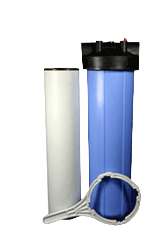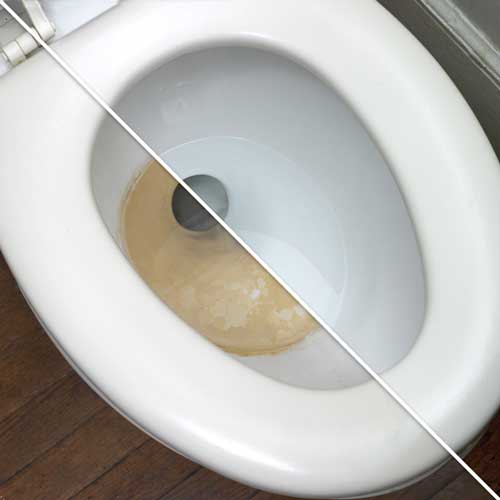
Iron can often be detected visibly in water or by staining on plumbing fixtures
Types of Iron
There are three main forms of iron and manganese. Other types are much rarer
- Ferrous - This type of iron is often called "clear water iron" since it is not visible in poured water. It is found in water which contains no oxygen, such as water from deep wells or groundwater. Carbon dioxide reacts with iron in the ground to form water-soluble ferrous bicarbonate, which, in the water, produces ferrous ions (Fe++).
- Ferric - Ferric iron is also known as "red water iron". This type of iron is basically ferrous iron which has been exposed to oxygen (oxidized), usually from the air. As carbon dioxide leave the water, oxygen combines with the iron to form ferric ions (Fe+++). These oxidized particles are generally visible in poured water.
- Bacterial Iron - Slime depositing in toilet tanks or fouling water filters and softeners is a good indication
 of the presence of bacterial iron. Better described as iron bio fouling, the iron bacteria problem is both complex and widespread. It attacks wells and water systems around the world in all sorts of aquifer environments, both contaminated and pristine. In some places, it causes great damage; in others, it is considered a minor nuisance.
of the presence of bacterial iron. Better described as iron bio fouling, the iron bacteria problem is both complex and widespread. It attacks wells and water systems around the world in all sorts of aquifer environments, both contaminated and pristine. In some places, it causes great damage; in others, it is considered a minor nuisance.
Treatment Methods for Iron Removal
Iron Bacteria
Iron bacteria can be controlled by periodic well chlorination or it can be treated in the building. The treatment involves the following: Chlorination, retention, filtration. Activated carbon is usually used as the filter material so the excess chlorine can also be removed.
Ferric Iron
In theory, the elimination of ferric iron is simple - use a properly sized media filter to filter it from the water. In practice, however there may be other issues:
- Some iron may be present in colloidal form. Unlike ferric iron, which will generally stick together to form large flakes, the tiny particles of colloidal iron do the opposite. Their large surface area and charge relative to their mass causes the individual particles to repel one another. As a result they will not coagulate. Their small size, then, makes them difficult to filter, and a coagulating agent is often required to obtain adequate filtration.
- Most water containing ferric iron also contains ferrous iron. This can add complexity to the process, since some of the methods for removing ferrous iron will also remove ferric iron.

Call us for the best prices and advice. Tel: 0845 10 80 680 / 01403 701970